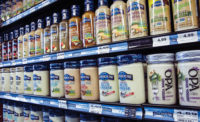
24-Hour Society
by Shonda Talerico Dudlicek
Contributing Editor
Busy lifestyles demand reclosable and resealable packages.
“Eat some now and save some for later, eat some now and save
some for later ...”
That jingle, which children of the 1980s should
remember from TV commercials for Now and Later candy, could be used to
describe consumers’ demands of reclosable, resealable dairy
packaging.
Maybe you just wanted a swig of vanilla milk now and
want to save the rest for a milk-and-cookies break later. You want the
reassurance that once the package is opened for that first drink or bite,
every other taste will be just as good.
And there’s that mantra of dieters: portion
control. Maybe you want only half of that yogurt for breakfast and plan to
take the rest to work for lunch. Will it spill if it tips over during your
commute?
One of the latest trends in resealable and reclosable
packaging is to offer closures that are quick and easy to open and have
easy-to-spot tamper evidency.
Consumers want “quick and reliable opening
features, and the ability to reseal easily so that shelf life is not
degraded,” says Chris Reilly, Spout-Pak® global business manager, Evergreen Packaging Inc.,
Memphis, Tenn. “Also, a strong desire to extend product shelf
life.”
Evergreen Packaging offers filling equipment for
dairy, juice and other liquid food products, gable-top cartons, spouts and
technical service to its customers.
Last year, IPEC, New Castle, Pa., successfully
introduced a 38-mm drop-lock design screw-on closure. “To the
consumer, it is aesthetically identical to our widely popular ISS closure
to allow dairies the ability to use multiple types of application, across
many different facilities and still ensure consistent branding and strong
tamper evidence,” says Jay Martin, IPEC’s vice president of
operations.
IPEC supplies plastic closures and equipment to the
dairy, water and juice industries and offers a full range of technical
service support for capping, filling and blow-mold operations. IPEC offers
13 different closure product lines, builds and installs custom conveyance
and capping equipment commonly used in dairies.
“Drop-lock-style closures have continued to grow
in popularity because of their ease of use, strong tamper evidency,”
Martin says, “and for marketing single-serve dairy products on
shelves next to soda, juice and sports drinks that are packaged with
similar drop-lock-style closures.”
The new closure’s design incorporates a
three-point sealing technology that ensures a consistent seal even on
bottles with common flaws seen in the industry, Martin says. Along with the
launch of this closure, the company developed a capping head design that is
more consistent, easier to clean, and requires less maintenance.
IPEC also developed a dairy closure that can be used
in place of the traditional ITC/SCII style closure commonly used in the
industry. The new closure requires no changes to feeding equipment,
cappers/fillers, or bottle finish, and improves the tamper evidency of the
finished package.
IPEC’s drop-lock design ISS (snap-screw) and ISO
(screw-on) closures are identical externally to allow companies the benefit
of consistent branding across their lines or multiple facilities,
regardless of their capping equipment that is currently in place. This
minimizes the capital expense and interruption to plant operations in order
to make the conversion to a drop-lock-style closure, Martin says.
Greener Packaging
Another trend, common to all industries, is packaging
with an environmental conscience.
“Like other segments, sustainable packaging [is a
trend]. Wal-Mart’s recent focus on the sustainability and the
environment has shifted the focus to ‘greener’
packaging,” says Michelle Schmitt, market analyst, Berry Plastics,
Evansville, Ind., adding that she also sees a demand for lightweighting
packaging to save resin.
Berry Plastics is a manufacturer of injection-molded
packaging, including thermoformed and tamper-resistant packaging. Product
lines include containers, drink cups, housewares, aerosol overcaps,
closures, bottles, tubes and prescription vials. The company serves the
dairy, food and beverage markets along with industrial, chemical, health
and beauty, and pharmaceutical industries.
Berry is equipped with a technical services group,
design center and in-house graphics department. Decorating options include
10-color offset printing, screen printing and heat transfer,
pressure-sensitive and in-mold labeling, the latter which continues to be a
trend, Schmitt says.
With its acquisition of Kerr Group, Berry Plastics now
offers an extensive line of tubed products and laminate-tube technology.
Evident Tamper Evidency
In today’s society, tamper evidency is a must for
packaging and its caps. Improvements on that end include moving away from
foil-seal tamper-evident features and toward pull-plug tamper-evident
features, Reilly says.
“They want a package and spout that will be able
to quickly demonstrate if a package has been tampered with,” Reilly
says of consumers.
Evergreen’s recent gable-top filling machine
introductions include Q-16, CQL-80, EH-3D and EH-3S, which all have
Spout-Pak as an option to respond to the needs of consumers, Reilly says.
Both consumers and dairy processors demand a higher
level of tamper evidence, says Douglas Henning, president, Blackhawk
Molding Co. Inc., Addison, Ill., a manufacturer of closures and capping
equipment and blow-mold bottle components specializing in neck inserts.
“A breach of a container should be clearly
visible,” Henning says. “The tamper ring can stay on or be
removed from bottle. Many people like to remove ring to prevent milk from
being caught between bottle neck and ring which can create unwanted milk
powder.”
Ensuring food safety is always important, Schmitt
says. “Incorporating tamper-resistant tabs can eliminate secondary
processes such as heat seals.”
Martin says with new drop-lock closures, the dairy
industry now has options that can solve tamper-evidency concerns, allow
marketing flexibility that they may require and can address some of the
functionality issues that consumers have faced for years.
“Older-style closures can be excessively
difficult to unscrew and other designs have required the end user to pull a
small tab, which can be challenging for certain age groups and people with
medical conditions,” he says. “The drop-lock design closures
will also not leave the consumer with a tamper-evident band floating in
their coffee or cereal after pouring since it remains with the
bottle.”
Great Expectations
When you come right down to it, processors and
consumers have a lot of the same packaging expectations.
“Today, most consumers expect their gable-top
carton to have a spout. In fact, if there is not a spout, the consumer will
want to know why it does not have one,” Reilly says. “The
challenge of new spout development is creating a product that satisfies the
needs of the processor and the end-use consumer.”
Reilly says processors want spouts that are effective.
“They want to ensure that their machine efficiencies are not
negatively impacted by the spout application process. They want spouts that
deliver greater value — cost less, but have differentiating
features.”
Martin says processors also want ease of use and
consistency in application on their filling line. “The processors
want ease of use and consistency, just as the end users do.”
Schmitt says processors want more bundling of
products, such as drinkable milk and cereal, and shelf-stable packaging for
freshness.
Consumers want packaging that’s easy to use and
consistently performs for them.
“Consumers don’t want to have to think
about why a cap does or doesn’t function well on a bottle,”
Martin says. “The purpose for the package is to transport and store
their milk. They want it to be simple and intuitive to open and
close.”
Reilly agrees. “They want to be able to quickly
determine if a package has been tampered with and to be able to easily open
a package. They also want to be able to reseal a package quickly and be
confident that it won’t leak if knocked over or placed on its
side.”
Because so many new packages are being developed for
single-serve use and on-the-go lifestyles, portability goes hand in hand
with reclosable, resealable packaging.
Says Schmitt, “Today’s ‘24-hour
society’ demands packages be convenient for busy lifestyles.”
Shonda Talerico Dudlicek is a freelance journalist and
a former managing editor of Dairy Field.
$OMN_arttitle="24-Hour Society";?>
$OMN_artauthor="Shonda Talerico Dudlicek";?>
